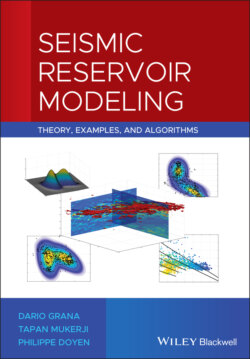Читать книгу Seismic Reservoir Modeling - Dario Grana - Страница 10
Preface
ОглавлениеGeophysical data are commonly acquired to understand the structure of the subsurface for a variety of applications, such as energy resource exploration, natural hazards, groundwater, and surface processes. Seismic reservoir modeling is an interdisciplinary field that integrates physics, mathematics, geology, statistics, and computer science. The goal of seismic reservoir characterization studies is to predict three‐dimensional models of rock and fluid properties in the subsurface based on the available geophysical data, such as borehole measurements and surface geophysical surveys. Mathematical methods are required to solve the so‐called inverse problem in which the properties of interest are estimated from their geophysical response. The solution to this problem is generally non‐unique owing to the data errors, their limited resolution, the physics approximations, and the natural variability and heterogeneity of porous rocks. Multiple model realizations of rock and fluid properties, constrained by geophysical measurements and prior geological information, can be generated by combining statistical methods and computer science algorithms.
The main goal of this book is to bring together in one place basic and advanced methodologies of the current state of the art in seismic reservoir characterization. This work finds inspiration in the book Seismic Reservoir Characterization by Philippe Doyen. For the rock physics part, it strongly relies on The Rock Physics Handbook by Gary Mavko, Tapan Mukerji, and Jack Dvorkin, whereas for the geostatistics part, it relies on Geostatistical Reservoir Modeling by Michael Pyrcz and Clayton Deutsch, and Multiple‐Point Geostatistics by Gregoire Mariethoz and Jef Caers. Unlike other textbooks on seismic reservoir modeling, this book offers a detailed description of the mathematical–physical methods used for quantitative seismic interpretation. Indeed, it focuses on mathematical methods for the estimation of petrophysical properties, such as porosity, mineral volumes, and fluid saturations from geophysical data and attributes. Owing to the non‐uniqueness of the solution, we present a set of probabilistic methods that aim to estimate the most likely model as well as the uncertainty associated with the predictions. The model uncertainty can be quantified using probability distributions, confidence intervals, or a set of model realizations.
Chapter 1 reviews the main mathematical and statistical concepts used in the methods proposed in this book. We first present a review of probability and statistics to familiarize the reader with the concept of probability distribution. We then introduce the notion of a mathematical inverse problem, where the model variables are estimated from a set of measurements, based on the physics operator that links the model variables to the measured data. The inverse problem is formulated in a Bayesian setting.
Chapter 2 includes an overview of rock physics models. A rock physics model is defined as one or multiple equations that compute the elastic response (P‐wave and S‐wave velocity and density) of a porous rock given its petrophysical properties (porosity, mineral volumes, and fluid saturations). Empirical and theoretical models are presented with examples in different geological environments.
Chapters 3 and 4 focus on geostatistical methods for spatial interpolation and simulation of multiple realizations of subsurface properties. Geostatistics is a branch of spatial statistics that aims to analyze and predict properties associated with spatiotemporal phenomena in geosciences. Spatial statistics notions and algorithms are commonly used in geoscience to mimic the spatial and temporal continuity of geological processes. Chapter 3 describes methods for the interpolation and stochastic simulation of continuous properties, such as petrophysical and elastic variables, whereas Chapter 4 extends these algorithms to discrete properties, such as rock types and facies. An example of application of geostatistical methods to elevation and temperature maps in the Yellowstone National Park is presented to illustrate the algorithms and compare the predictions with the exact measurements.
Chapter 5 summarizes the developments in seismic and petrophysical inverse problems of the past two decades. The chapter includes three main topics: Bayesian linearized AVO inversion, Bayesian rock physics inversion, and geostatistical inversion. Bayesian linearized AVO inversion is an elegant and efficient algorithm proposed by Arild Buland and Henning Omre for the prediction of elastic properties from measured seismic data. Bayesian rock physics inversion refers to a set of probabilistic methods for the prediction of petrophysical properties from elastic attributes, based on different statistical assumptions for the distribution of the model variables and different linear or non‐linear rock physics models. Geostatistical inversion methods include multiple stochastic algorithms that aim to predict petrophysical properties from measured seismic data, by iteratively perturbing and updating an initial realization or a set of realizations. All the methodologies are illustrated through one‐dimensional examples based on borehole data.
Chapter 6 extends the Bayesian inversion methodology to facies classification and to joint inversion of facies and petrophysical properties from seismic data. This chapter discusses traditional Bayesian facies classification methods based on seismic data and seismically derived attributes, and introduces recent advances in stochastic sampling methods for the joint prediction of facies and reservoir properties, integrating Bayesian inverse theory and geostatistical algorithms.
Chapter 7 introduces additional sources of uncertainty associated with data processing, natural heterogeneity, and geological interpretation, and elaborates on the integration of seismic reservoir characterization methods in other domains of reservoir modeling. The chapter discusses the application of seismic and petrophysical inversion methods to time‐lapse geophysical data, the use of different geophysical datasets, such as electromagnetic data, and the assimilation of seismic data in fluid flow simulation for updating the reservoir model in monitoring studies. These topics introduce recent research challenges and directions. Probabilistic model predictions are also used in decision‐making studies associated with the value of information of geophysical data.
Chapter 8 presents several case studies previously published in peer‐reviewed journals. The applications include two hydrocarbon reservoirs in the Norwegian Sea, a carbonate field offshore Brazil, and a CO2 sequestration study offshore Norway.
The Appendix contains the description of the Seismic Reservoir Modeling (SeReM) MATLAB package including codes for rock physics, geostatistics, inversion, and facies modeling. The Matlab package SeReM and the Python version SeReMpy are available at the following link: https://seismicreservoirmodeling.github.io/SeReM/.
